Commercial and Corporation Law: ACCC v TPG & Contract Law
VerifiedAdded on 2023/06/07
|8
|1729
|205
Report
AI Summary
This report provides a detailed analysis of two key scenarios within commercial and corporation law. The first part examines the case of ACCC v TPG Internet Pty Ltd., focusing on issues of fraudulent misrepresentation and the existence of a duty of care. It delves into the legal principles, including the elements of fraudulent misrepresentation and the application of these principles to the facts of the case. The report explores the court's decision, the concept of misrepresentation in tort law, and the remedies available. The second part addresses a scenario involving a jewelry business, focusing on whether one party can enforce the terms of a contract against another, specifically concerning an exclusion clause or restrictive covenant. It explores the legal principles of contract law, including the formation of contracts, breach of contract, and the role of exclusion clauses. The analysis considers the application of these principles to the scenario's facts, including the enforceability of the restrictive covenant and the remedies available to the parties involved. The report concludes with a summary of the court's findings and the remedies, if any, that could be pursued by the involved parties.
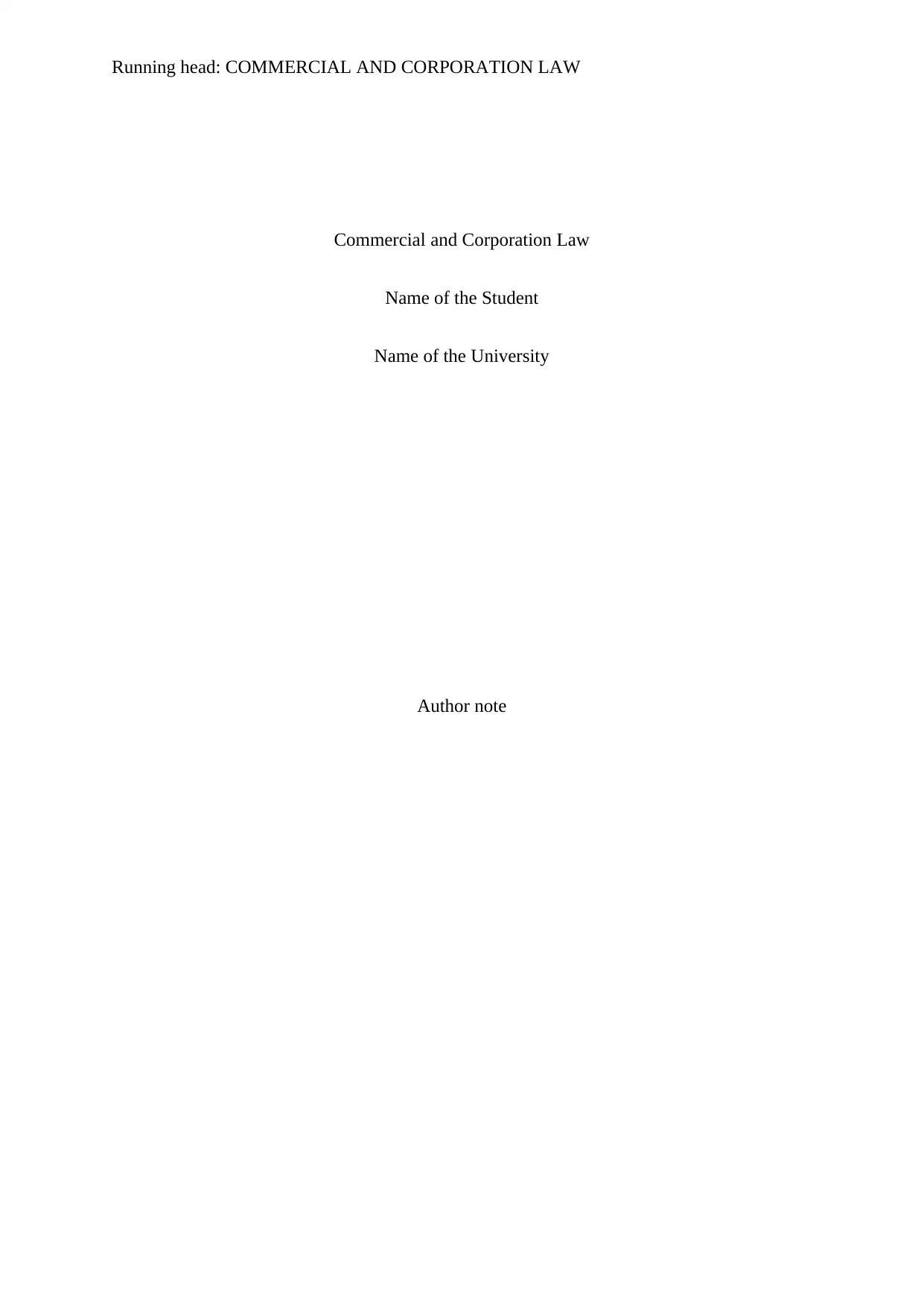
Running head: COMMERCIAL AND CORPORATION LAW
Commercial and Corporation Law
Name of the Student
Name of the University
Author note
Commercial and Corporation Law
Name of the Student
Name of the University
Author note
Paraphrase This Document
Need a fresh take? Get an instant paraphrase of this document with our AI Paraphraser
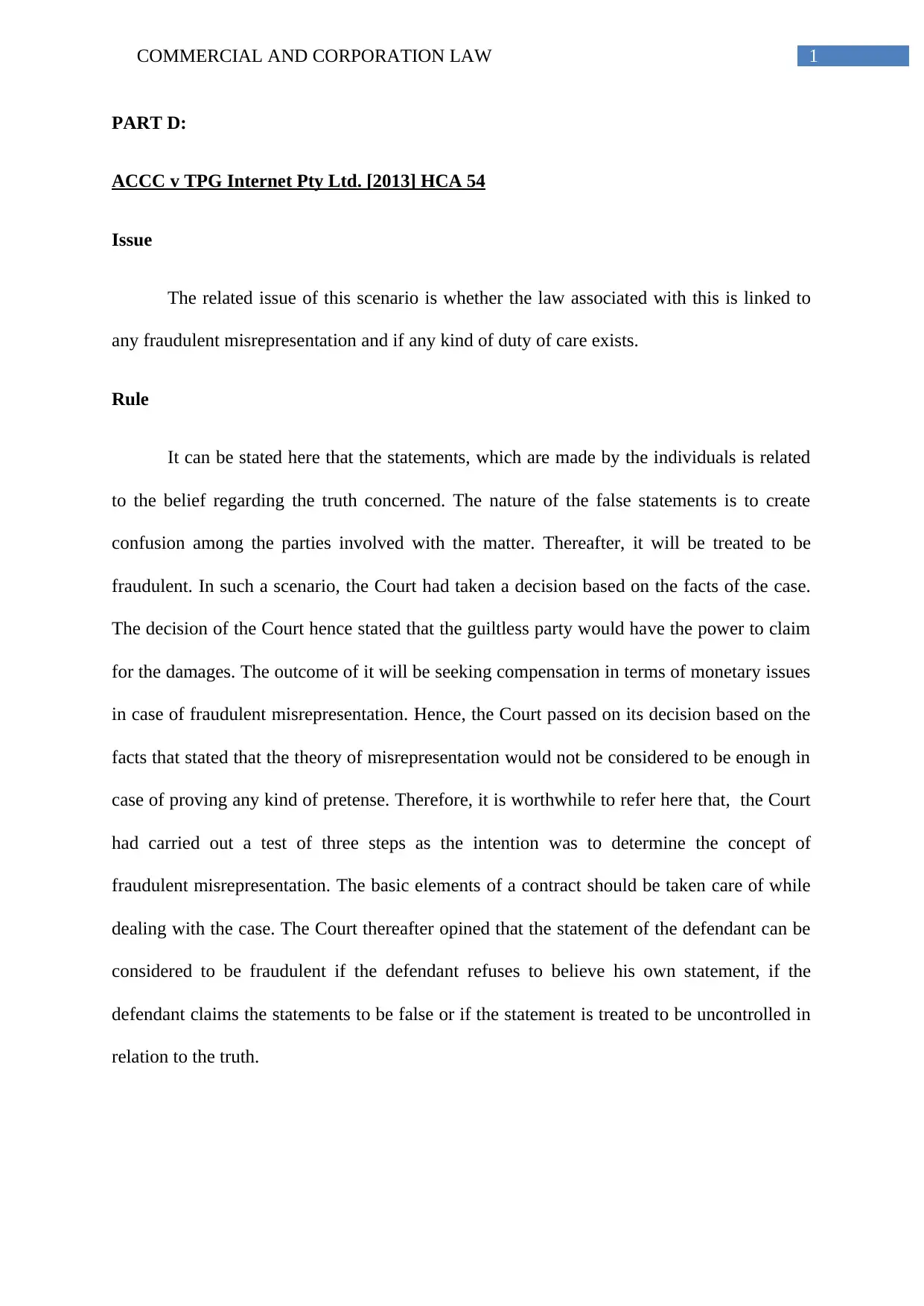
1COMMERCIAL AND CORPORATION LAW
PART D:
ACCC v TPG Internet Pty Ltd. [2013] HCA 54
Issue
The related issue of this scenario is whether the law associated with this is linked to
any fraudulent misrepresentation and if any kind of duty of care exists.
Rule
It can be stated here that the statements, which are made by the individuals is related
to the belief regarding the truth concerned. The nature of the false statements is to create
confusion among the parties involved with the matter. Thereafter, it will be treated to be
fraudulent. In such a scenario, the Court had taken a decision based on the facts of the case.
The decision of the Court hence stated that the guiltless party would have the power to claim
for the damages. The outcome of it will be seeking compensation in terms of monetary issues
in case of fraudulent misrepresentation. Hence, the Court passed on its decision based on the
facts that stated that the theory of misrepresentation would not be considered to be enough in
case of proving any kind of pretense. Therefore, it is worthwhile to refer here that, the Court
had carried out a test of three steps as the intention was to determine the concept of
fraudulent misrepresentation. The basic elements of a contract should be taken care of while
dealing with the case. The Court thereafter opined that the statement of the defendant can be
considered to be fraudulent if the defendant refuses to believe his own statement, if the
defendant claims the statements to be false or if the statement is treated to be uncontrolled in
relation to the truth.
PART D:
ACCC v TPG Internet Pty Ltd. [2013] HCA 54
Issue
The related issue of this scenario is whether the law associated with this is linked to
any fraudulent misrepresentation and if any kind of duty of care exists.
Rule
It can be stated here that the statements, which are made by the individuals is related
to the belief regarding the truth concerned. The nature of the false statements is to create
confusion among the parties involved with the matter. Thereafter, it will be treated to be
fraudulent. In such a scenario, the Court had taken a decision based on the facts of the case.
The decision of the Court hence stated that the guiltless party would have the power to claim
for the damages. The outcome of it will be seeking compensation in terms of monetary issues
in case of fraudulent misrepresentation. Hence, the Court passed on its decision based on the
facts that stated that the theory of misrepresentation would not be considered to be enough in
case of proving any kind of pretense. Therefore, it is worthwhile to refer here that, the Court
had carried out a test of three steps as the intention was to determine the concept of
fraudulent misrepresentation. The basic elements of a contract should be taken care of while
dealing with the case. The Court thereafter opined that the statement of the defendant can be
considered to be fraudulent if the defendant refuses to believe his own statement, if the
defendant claims the statements to be false or if the statement is treated to be uncontrolled in
relation to the truth.
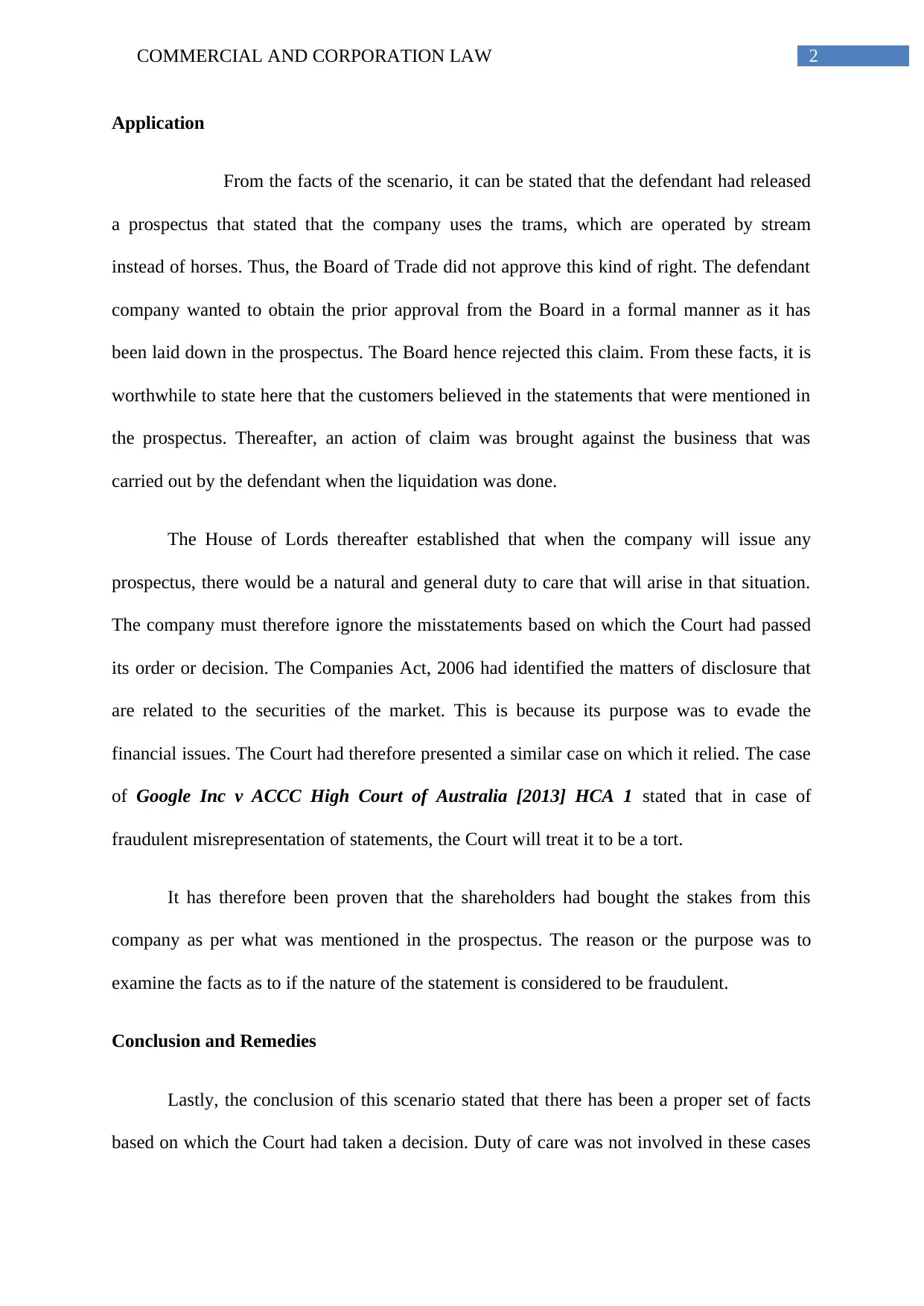
2COMMERCIAL AND CORPORATION LAW
Application
From the facts of the scenario, it can be stated that the defendant had released
a prospectus that stated that the company uses the trams, which are operated by stream
instead of horses. Thus, the Board of Trade did not approve this kind of right. The defendant
company wanted to obtain the prior approval from the Board in a formal manner as it has
been laid down in the prospectus. The Board hence rejected this claim. From these facts, it is
worthwhile to state here that the customers believed in the statements that were mentioned in
the prospectus. Thereafter, an action of claim was brought against the business that was
carried out by the defendant when the liquidation was done.
The House of Lords thereafter established that when the company will issue any
prospectus, there would be a natural and general duty to care that will arise in that situation.
The company must therefore ignore the misstatements based on which the Court had passed
its order or decision. The Companies Act, 2006 had identified the matters of disclosure that
are related to the securities of the market. This is because its purpose was to evade the
financial issues. The Court had therefore presented a similar case on which it relied. The case
of Google Inc v ACCC High Court of Australia [2013] HCA 1 stated that in case of
fraudulent misrepresentation of statements, the Court will treat it to be a tort.
It has therefore been proven that the shareholders had bought the stakes from this
company as per what was mentioned in the prospectus. The reason or the purpose was to
examine the facts as to if the nature of the statement is considered to be fraudulent.
Conclusion and Remedies
Lastly, the conclusion of this scenario stated that there has been a proper set of facts
based on which the Court had taken a decision. Duty of care was not involved in these cases
Application
From the facts of the scenario, it can be stated that the defendant had released
a prospectus that stated that the company uses the trams, which are operated by stream
instead of horses. Thus, the Board of Trade did not approve this kind of right. The defendant
company wanted to obtain the prior approval from the Board in a formal manner as it has
been laid down in the prospectus. The Board hence rejected this claim. From these facts, it is
worthwhile to state here that the customers believed in the statements that were mentioned in
the prospectus. Thereafter, an action of claim was brought against the business that was
carried out by the defendant when the liquidation was done.
The House of Lords thereafter established that when the company will issue any
prospectus, there would be a natural and general duty to care that will arise in that situation.
The company must therefore ignore the misstatements based on which the Court had passed
its order or decision. The Companies Act, 2006 had identified the matters of disclosure that
are related to the securities of the market. This is because its purpose was to evade the
financial issues. The Court had therefore presented a similar case on which it relied. The case
of Google Inc v ACCC High Court of Australia [2013] HCA 1 stated that in case of
fraudulent misrepresentation of statements, the Court will treat it to be a tort.
It has therefore been proven that the shareholders had bought the stakes from this
company as per what was mentioned in the prospectus. The reason or the purpose was to
examine the facts as to if the nature of the statement is considered to be fraudulent.
Conclusion and Remedies
Lastly, the conclusion of this scenario stated that there has been a proper set of facts
based on which the Court had taken a decision. Duty of care was not involved in these cases
⊘ This is a preview!⊘
Do you want full access?
Subscribe today to unlock all pages.

Trusted by 1+ million students worldwide
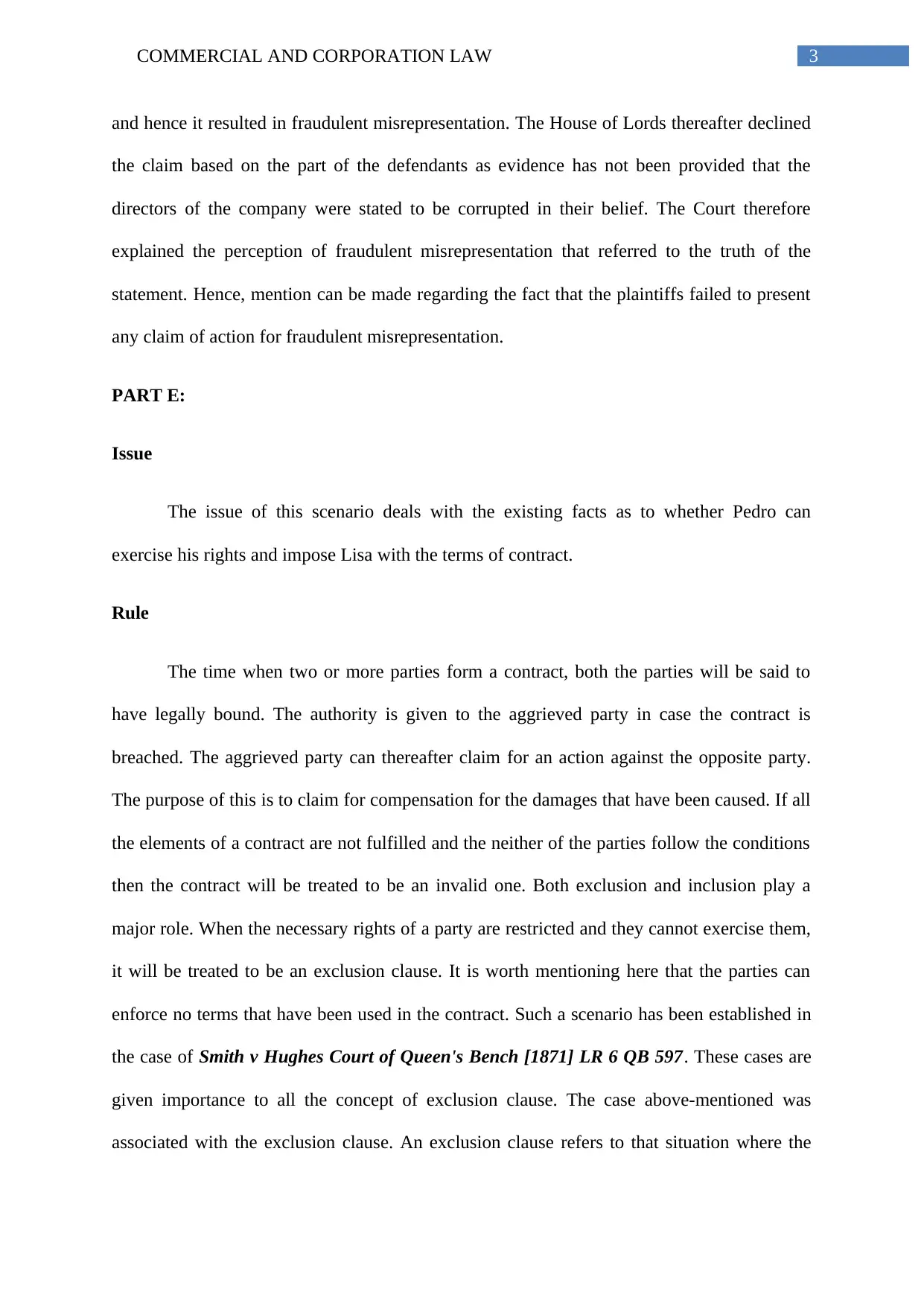
3COMMERCIAL AND CORPORATION LAW
and hence it resulted in fraudulent misrepresentation. The House of Lords thereafter declined
the claim based on the part of the defendants as evidence has not been provided that the
directors of the company were stated to be corrupted in their belief. The Court therefore
explained the perception of fraudulent misrepresentation that referred to the truth of the
statement. Hence, mention can be made regarding the fact that the plaintiffs failed to present
any claim of action for fraudulent misrepresentation.
PART E:
Issue
The issue of this scenario deals with the existing facts as to whether Pedro can
exercise his rights and impose Lisa with the terms of contract.
Rule
The time when two or more parties form a contract, both the parties will be said to
have legally bound. The authority is given to the aggrieved party in case the contract is
breached. The aggrieved party can thereafter claim for an action against the opposite party.
The purpose of this is to claim for compensation for the damages that have been caused. If all
the elements of a contract are not fulfilled and the neither of the parties follow the conditions
then the contract will be treated to be an invalid one. Both exclusion and inclusion play a
major role. When the necessary rights of a party are restricted and they cannot exercise them,
it will be treated to be an exclusion clause. It is worth mentioning here that the parties can
enforce no terms that have been used in the contract. Such a scenario has been established in
the case of Smith v Hughes Court of Queen's Bench [1871] LR 6 QB 597. These cases are
given importance to all the concept of exclusion clause. The case above-mentioned was
associated with the exclusion clause. An exclusion clause refers to that situation where the
and hence it resulted in fraudulent misrepresentation. The House of Lords thereafter declined
the claim based on the part of the defendants as evidence has not been provided that the
directors of the company were stated to be corrupted in their belief. The Court therefore
explained the perception of fraudulent misrepresentation that referred to the truth of the
statement. Hence, mention can be made regarding the fact that the plaintiffs failed to present
any claim of action for fraudulent misrepresentation.
PART E:
Issue
The issue of this scenario deals with the existing facts as to whether Pedro can
exercise his rights and impose Lisa with the terms of contract.
Rule
The time when two or more parties form a contract, both the parties will be said to
have legally bound. The authority is given to the aggrieved party in case the contract is
breached. The aggrieved party can thereafter claim for an action against the opposite party.
The purpose of this is to claim for compensation for the damages that have been caused. If all
the elements of a contract are not fulfilled and the neither of the parties follow the conditions
then the contract will be treated to be an invalid one. Both exclusion and inclusion play a
major role. When the necessary rights of a party are restricted and they cannot exercise them,
it will be treated to be an exclusion clause. It is worth mentioning here that the parties can
enforce no terms that have been used in the contract. Such a scenario has been established in
the case of Smith v Hughes Court of Queen's Bench [1871] LR 6 QB 597. These cases are
given importance to all the concept of exclusion clause. The case above-mentioned was
associated with the exclusion clause. An exclusion clause refers to that situation where the
Paraphrase This Document
Need a fresh take? Get an instant paraphrase of this document with our AI Paraphraser
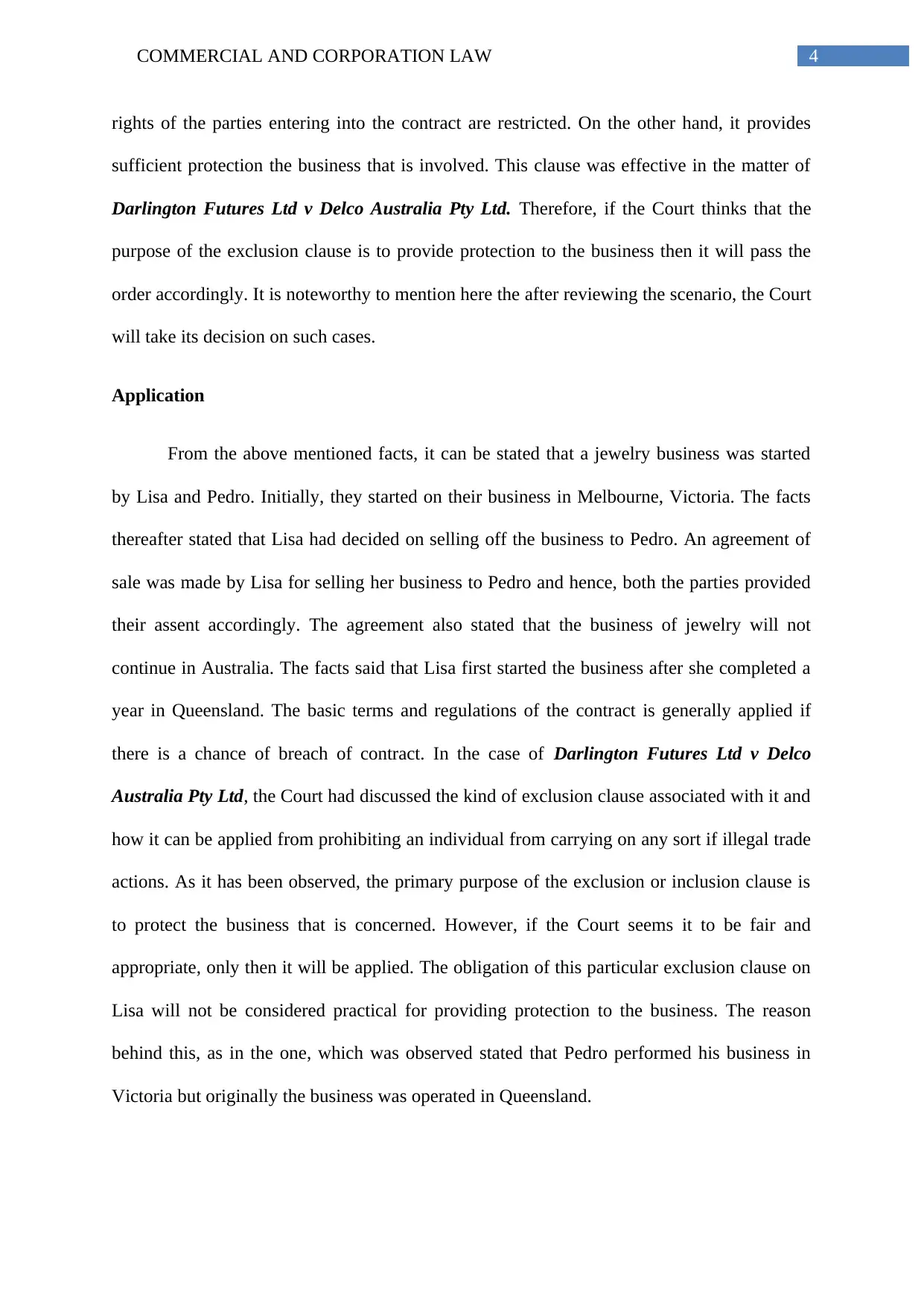
4COMMERCIAL AND CORPORATION LAW
rights of the parties entering into the contract are restricted. On the other hand, it provides
sufficient protection the business that is involved. This clause was effective in the matter of
Darlington Futures Ltd v Delco Australia Pty Ltd. Therefore, if the Court thinks that the
purpose of the exclusion clause is to provide protection to the business then it will pass the
order accordingly. It is noteworthy to mention here the after reviewing the scenario, the Court
will take its decision on such cases.
Application
From the above mentioned facts, it can be stated that a jewelry business was started
by Lisa and Pedro. Initially, they started on their business in Melbourne, Victoria. The facts
thereafter stated that Lisa had decided on selling off the business to Pedro. An agreement of
sale was made by Lisa for selling her business to Pedro and hence, both the parties provided
their assent accordingly. The agreement also stated that the business of jewelry will not
continue in Australia. The facts said that Lisa first started the business after she completed a
year in Queensland. The basic terms and regulations of the contract is generally applied if
there is a chance of breach of contract. In the case of Darlington Futures Ltd v Delco
Australia Pty Ltd, the Court had discussed the kind of exclusion clause associated with it and
how it can be applied from prohibiting an individual from carrying on any sort if illegal trade
actions. As it has been observed, the primary purpose of the exclusion or inclusion clause is
to protect the business that is concerned. However, if the Court seems it to be fair and
appropriate, only then it will be applied. The obligation of this particular exclusion clause on
Lisa will not be considered practical for providing protection to the business. The reason
behind this, as in the one, which was observed stated that Pedro performed his business in
Victoria but originally the business was operated in Queensland.
rights of the parties entering into the contract are restricted. On the other hand, it provides
sufficient protection the business that is involved. This clause was effective in the matter of
Darlington Futures Ltd v Delco Australia Pty Ltd. Therefore, if the Court thinks that the
purpose of the exclusion clause is to provide protection to the business then it will pass the
order accordingly. It is noteworthy to mention here the after reviewing the scenario, the Court
will take its decision on such cases.
Application
From the above mentioned facts, it can be stated that a jewelry business was started
by Lisa and Pedro. Initially, they started on their business in Melbourne, Victoria. The facts
thereafter stated that Lisa had decided on selling off the business to Pedro. An agreement of
sale was made by Lisa for selling her business to Pedro and hence, both the parties provided
their assent accordingly. The agreement also stated that the business of jewelry will not
continue in Australia. The facts said that Lisa first started the business after she completed a
year in Queensland. The basic terms and regulations of the contract is generally applied if
there is a chance of breach of contract. In the case of Darlington Futures Ltd v Delco
Australia Pty Ltd, the Court had discussed the kind of exclusion clause associated with it and
how it can be applied from prohibiting an individual from carrying on any sort if illegal trade
actions. As it has been observed, the primary purpose of the exclusion or inclusion clause is
to protect the business that is concerned. However, if the Court seems it to be fair and
appropriate, only then it will be applied. The obligation of this particular exclusion clause on
Lisa will not be considered practical for providing protection to the business. The reason
behind this, as in the one, which was observed stated that Pedro performed his business in
Victoria but originally the business was operated in Queensland.
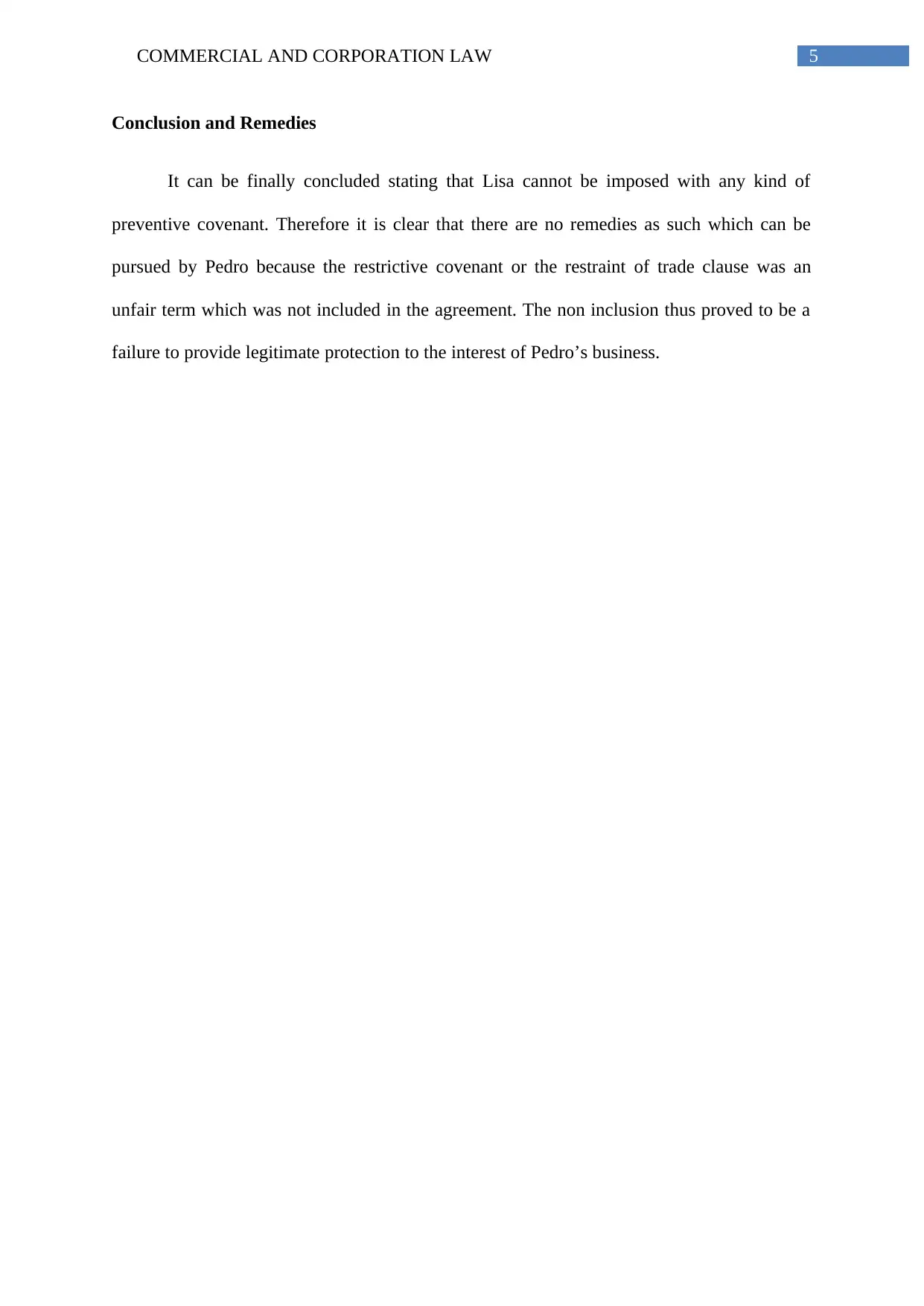
5COMMERCIAL AND CORPORATION LAW
Conclusion and Remedies
It can be finally concluded stating that Lisa cannot be imposed with any kind of
preventive covenant. Therefore it is clear that there are no remedies as such which can be
pursued by Pedro because the restrictive covenant or the restraint of trade clause was an
unfair term which was not included in the agreement. The non inclusion thus proved to be a
failure to provide legitimate protection to the interest of Pedro’s business.
Conclusion and Remedies
It can be finally concluded stating that Lisa cannot be imposed with any kind of
preventive covenant. Therefore it is clear that there are no remedies as such which can be
pursued by Pedro because the restrictive covenant or the restraint of trade clause was an
unfair term which was not included in the agreement. The non inclusion thus proved to be a
failure to provide legitimate protection to the interest of Pedro’s business.
⊘ This is a preview!⊘
Do you want full access?
Subscribe today to unlock all pages.

Trusted by 1+ million students worldwide
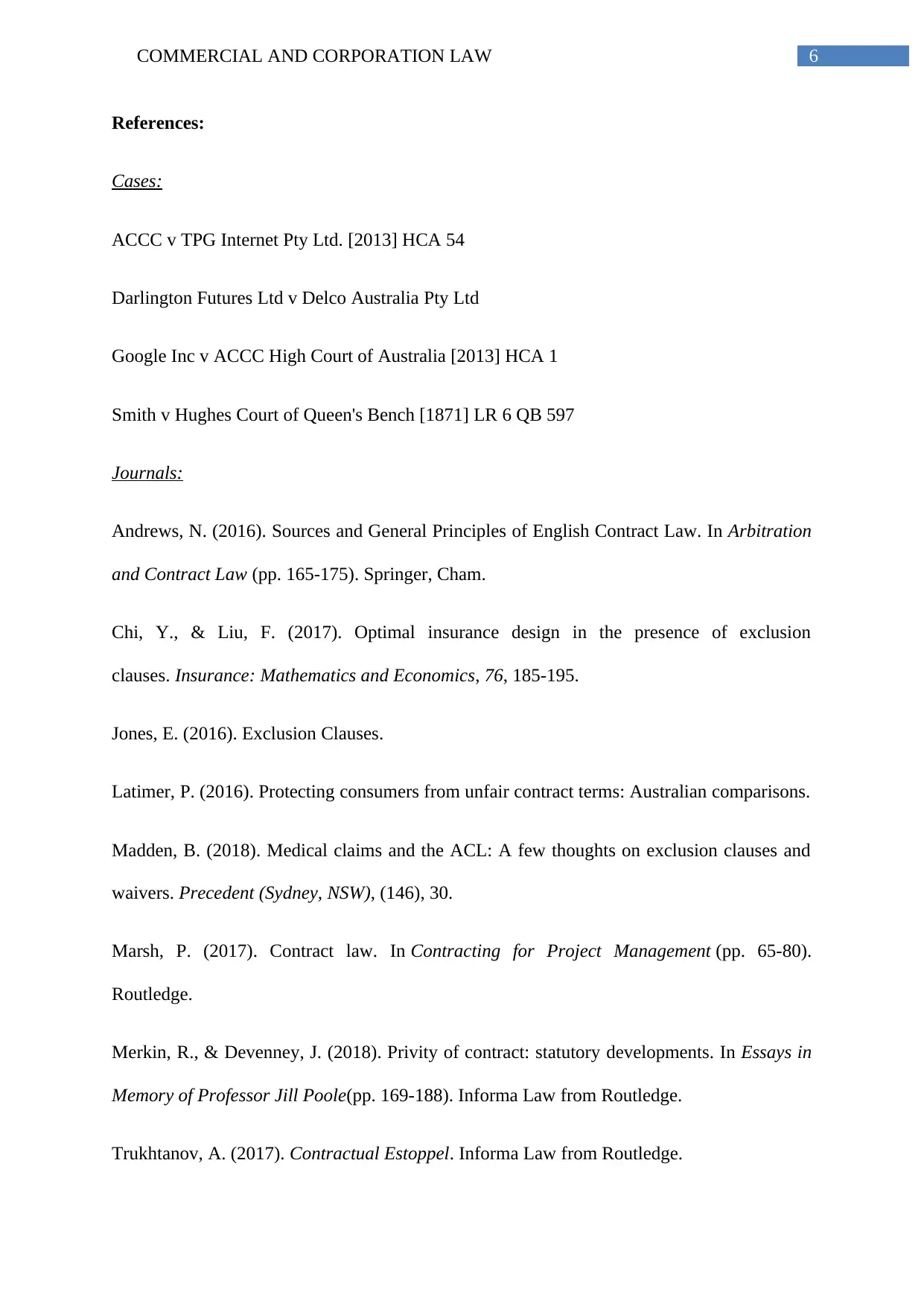
6COMMERCIAL AND CORPORATION LAW
References:
Cases:
ACCC v TPG Internet Pty Ltd. [2013] HCA 54
Darlington Futures Ltd v Delco Australia Pty Ltd
Google Inc v ACCC High Court of Australia [2013] HCA 1
Smith v Hughes Court of Queen's Bench [1871] LR 6 QB 597
Journals:
Andrews, N. (2016). Sources and General Principles of English Contract Law. In Arbitration
and Contract Law (pp. 165-175). Springer, Cham.
Chi, Y., & Liu, F. (2017). Optimal insurance design in the presence of exclusion
clauses. Insurance: Mathematics and Economics, 76, 185-195.
Jones, E. (2016). Exclusion Clauses.
Latimer, P. (2016). Protecting consumers from unfair contract terms: Australian comparisons.
Madden, B. (2018). Medical claims and the ACL: A few thoughts on exclusion clauses and
waivers. Precedent (Sydney, NSW), (146), 30.
Marsh, P. (2017). Contract law. In Contracting for Project Management (pp. 65-80).
Routledge.
Merkin, R., & Devenney, J. (2018). Privity of contract: statutory developments. In Essays in
Memory of Professor Jill Poole(pp. 169-188). Informa Law from Routledge.
Trukhtanov, A. (2017). Contractual Estoppel. Informa Law from Routledge.
References:
Cases:
ACCC v TPG Internet Pty Ltd. [2013] HCA 54
Darlington Futures Ltd v Delco Australia Pty Ltd
Google Inc v ACCC High Court of Australia [2013] HCA 1
Smith v Hughes Court of Queen's Bench [1871] LR 6 QB 597
Journals:
Andrews, N. (2016). Sources and General Principles of English Contract Law. In Arbitration
and Contract Law (pp. 165-175). Springer, Cham.
Chi, Y., & Liu, F. (2017). Optimal insurance design in the presence of exclusion
clauses. Insurance: Mathematics and Economics, 76, 185-195.
Jones, E. (2016). Exclusion Clauses.
Latimer, P. (2016). Protecting consumers from unfair contract terms: Australian comparisons.
Madden, B. (2018). Medical claims and the ACL: A few thoughts on exclusion clauses and
waivers. Precedent (Sydney, NSW), (146), 30.
Marsh, P. (2017). Contract law. In Contracting for Project Management (pp. 65-80).
Routledge.
Merkin, R., & Devenney, J. (2018). Privity of contract: statutory developments. In Essays in
Memory of Professor Jill Poole(pp. 169-188). Informa Law from Routledge.
Trukhtanov, A. (2017). Contractual Estoppel. Informa Law from Routledge.
Paraphrase This Document
Need a fresh take? Get an instant paraphrase of this document with our AI Paraphraser
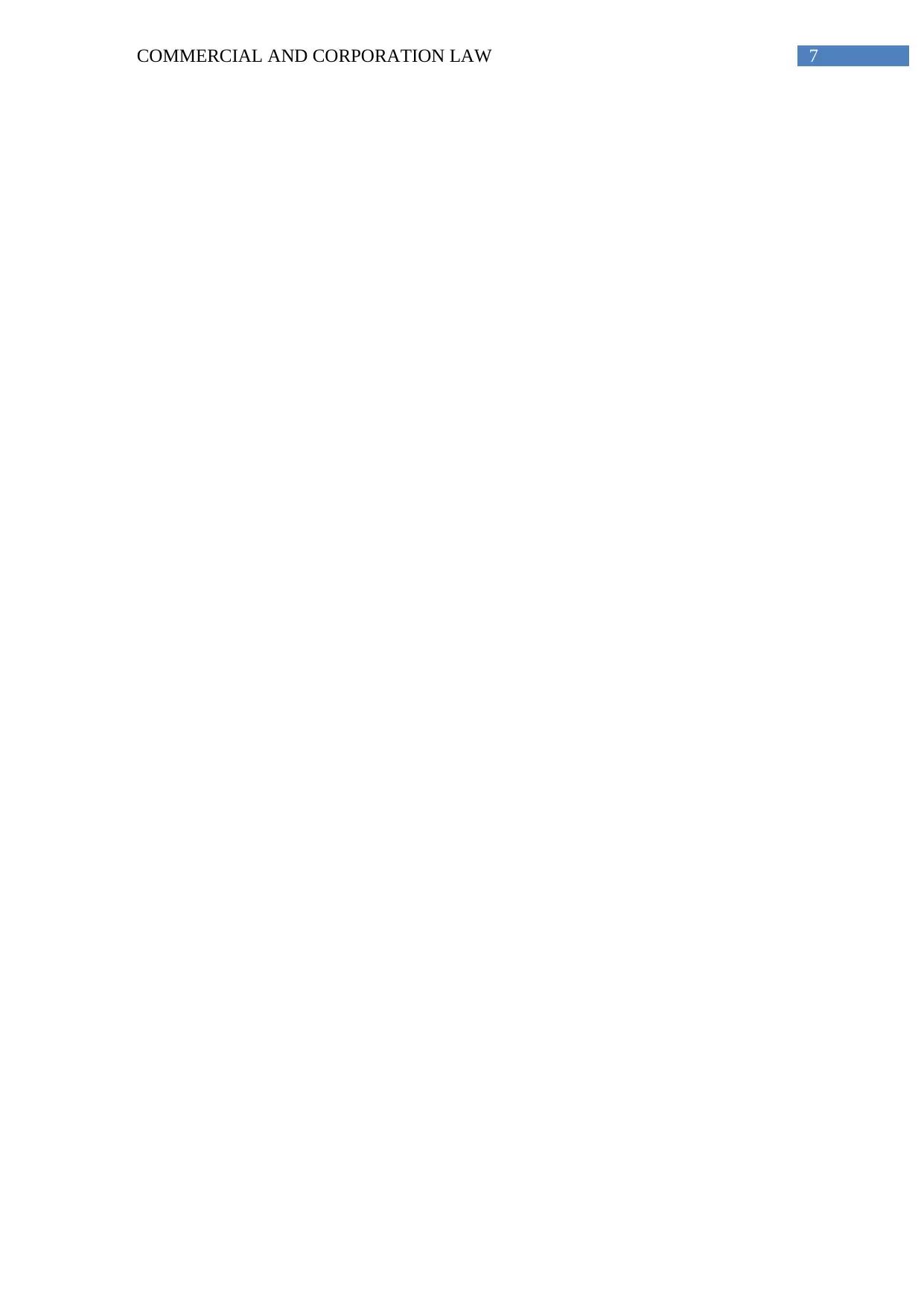
7COMMERCIAL AND CORPORATION LAW
1 out of 8
Related Documents
Your All-in-One AI-Powered Toolkit for Academic Success.
+13062052269
info@desklib.com
Available 24*7 on WhatsApp / Email
![[object Object]](/_next/static/media/star-bottom.7253800d.svg)
Unlock your academic potential
Copyright © 2020–2025 A2Z Services. All Rights Reserved. Developed and managed by ZUCOL.




